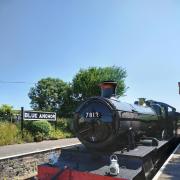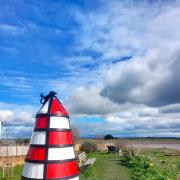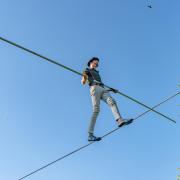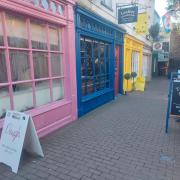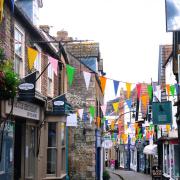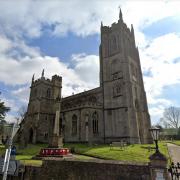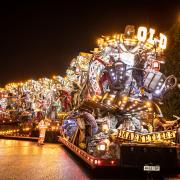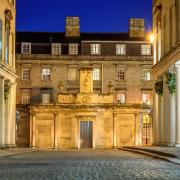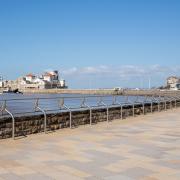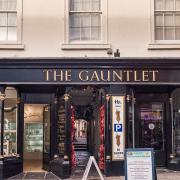We trace the Somerset railway locations used for a 1950s film

The Titfield Thunderbolt (filmed summer 1952, released 1953) was the first Ealing Studios comedy shot in colour, with most of the location filming in Somerset.
The film's premise is simple. When a rural branch line (the Titfield branch) is threatened with closure by British Rail, a group of local volunteers tries to run the railway. Provided they can find the cash and pass inspection then the railway might continue. This is in the face of opposition, however, not least from a local bus operator looking to benefit from the line's demise.
I wondered if I could track down exactly where the 'Thunderbolt' was filmed and find some railway remains along the way. So, where to head? The main filming location was a seven-mile stretch of line between Camerton and Limpley Stoke, not many miles south of Bath. This broadly west-east line connected with routes leading into both Bath and Bristol and is still discernible in places. The line was always destined to fail, as most traffic in the area was resolutely north-south.

In the film the volunteers see off the bus company and prevail. The line they 'saved' in the film had already closed in real life. Passenger services began on the branch in May 1910 yet were suspended in March 1915 as a wartime economy. Resumed in July 1923, following local pressure, they ceased again in September 1925. It then became a freight-only line (mostly coal) until final closure in 1951, with track lifting following in 1958.
At the west end of the line was Hallatrow, a junction for a now closed line up to Bristol. Heading east from Hallatrow was Camerton, then Midford, where our line crossed with the Somerset & Dorset Junction Railway coming down from Bath. Further east was Monkton Combe, which doubled up as Titfield for the film, then the line arrived at Limpley Stoke, another junction, this time with today's extant line between Bath and Westbury. The fictional railway had to be a railway to somewhere, of course, and it duly arrived at 'Mallingford' (Bristol Temple Meads in the real world).
The fact that two lines crossed at Midford was perfect as this conjured a classic opening scene when an express train (hauled by a Bullied loco) crossed Midford Viaduct above the Titfield branch train, which is on its way into Mallingford.

There were also bridges (railway over and under) which gave the opportunity to emphasise rail and bus rivalry. In one scene the bus crosses a bridge over the Titfield train (A36/B3108 junction in between Monkton Combe and Limpley Stoke), while another clip sees the roles reversed (Midford Road, Midford), as the train heads towards Mallingford.
The real line had much industrial heritage as North Somerset had an extensive coalfield. Dunkerton Colliery, in between Camerton and Midford, was used for the scene where the Titfield loco (ex-GWR 1400 class 0-4-2T loco no. 1401) and a traction engine cum steam roller belonging to Harry Hawkins (Sid James) engage in 'thou shalt not pass' pushing and shoving. The loco wins on this occasion. Another early scene in which the local squire (Gordon Chesterford, played by John Gregson) tries to overtake the same traction engine, was filmed at Carlingcott, close to Camerton. When the branch loco is finally nobbled by the railway's rivals, it is a museum piece that saves the day, the 'Thunderbolt' of the title, which was actually 'Lion'.
But, what of Monkton Combe? Just a couple of miles south-east of Bath, the station had been closed to passengers as long ago as 1925, however, the line remained open for freight until the closure of another of those collieries at Camerton, in 1950. This gave the film the opportunity to use a closed, but still intact line: a window of opportunity before track lifting commenced.

Arriving at what was the station site, I was greeted by a changed spectacle. The station is no more sadly (demolished in 1958), the site buried under tennis courts belonging to a school. The station was in Mill Lane. If you look hard at the film, you will spot other bits of the village. There's a distinctive mill chimney (still extant) and the road down which the train's patrons head is that self-same Mill Lane: it's barely changed.
To get an appreciation of what the station may have looked like, I headed to nearby Limpley Stoke, as this station survives, albeit closed and the building no longer in railway use. The word is the two stations were identical. I was staying at the Limpley Stoke Hotel, just a couple of hundred yards walk uphill from the station. Emerging from the hotel's approach road I found the 'Station Garage', then the station, which is raised up above the road on a stone wall.
Steps (padlocked shut) lead up to the platform, which is fenced off from the tracks. Trains still hurtle through, but no-one has alighted at Limpley Stoke in a long time. The Limpley Stoke cricket ground stars in the film, when a train comes puffing past with a match in progress.
Not all the Titfield village scenes were filmed in Monkton Combe. A little further south-east is Freshford, which was also used for village street scenes, plus the house of the man who stumps up the cash, the inveterate boozer, Walter Valentine (Stanley Holloway). 'Valentine's House' is in fact the Old Parsonage, down Church Hill from the church where the train-driving vicar presides (Sam Weech, played by George Relph).
The Old Brewery, which features, with its tall stone chimney, has been converted into a luxury home. Freshford still has its station, the first out of Bath, on that Westbury line.
Thunderbolt was not the only film causing crews to head for the branch. Arnold Ridley's The Ghost Train was filmed at Camerton in 1931, when a train of six corridor coaches and dining car (ostensibly the 'Cornish Riviera Express') ran over the line, probably the longest passenger train ever to do so. Night scenes for an Edgar Wallace thriller, Kate Plus Ten, were also filmed at Dunkerton Colliery Sidings in 1937.
The Titfield film has a happy ending. As well as the heroic triumvirate who succeed in saving the railway (Valentine, Chesterford and Weech), it has other supporters, including Dan, who helps with the engine driving (both sober and 'four sails to the wind'), and Joan (Gabrielle Brune), who serves the drinks, both in the pub and on the train. The railway line may not have survived in real life, but this is a lovely piece of Somerset to explore, in search of The Titfield Thunderbolt.




